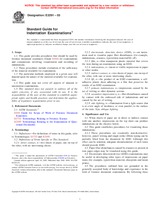We need your consent to use the individual data so that you can see information about your interests, among other things. Click "OK" to give your consent.
ASTM E2291-03
Standard Guide for Indentation Examinations (Withdrawn 2012)
Automatically translated name:
Standard Guide for Indentation Examinations (Withdrawn 2003)
STANDARD published on 10.4.2003
The information about the standard:
Designation standards: ASTM E2291-03
Note: WITHDRAWN
Publication date standards: 10.4.2003
SKU: NS-44933
The number of pages: 3
Approximate weight : 9 g (0.02 lbs)
Country: American technical standard
Category: Technical standards ASTM
Annotation of standard text ASTM E2291-03 :
Keywords:
electrostatic detection device (EDD), embossing, forensic science, indentations, questioned documents, ICS Number Code 07.140 (Forensic science)
Additional information
| Significance and Use | ||||||
|
When sheets of paper are in direct or indirect contact with one another, impressions on the top sheet can produce indentations on the sheet(s) below. This guide establishes procedures for visualizing those indentations. 4.2.1 These procedures are essentially non-destructive; however, pencil writing and single-strike ribbon typing can be partially lifted from the document by EDD. Although this effect can be minimal, adequate documentation of such items should precede EDD. Paper fiber disturbances caused by erasures or present in torn paper edges may be visualized using this guide. Electrostatic detection device (EDD) examinations may be useful in developing other types of impressions on paper items (for example, typewritten material, shoeprints and latent prints). The procedures outlined here are grounded in the generally accepted body of knowledge and experience in the field of forensic document examination. By following these procedures, a forensic document examiner can reliably reach an opinion concerning indentations. |
||||||
| 1. Scope | ||||||
|
1.1 This guide provides procedures that should be used by forensic document examiners (E 444) for examinations and comparisons involving visualization and recording of indentations. 1.2 These procedures include evaluation of the sufficiency of the material available for examination. 1.3 The particular methods employed in a given case will depend upon the nature of the material available for examination. 1.4 This guide may not cover all aspects of unusual or uncommon examinations. 1.5 This standard does not purport to address all of the safety concerns, if any, associated with its use. It is the responsibility of the user of this standard to establish appropriate safety and health practices and determine the applicability of regulatory requirements prior to use. |
||||||
| 2. Referenced Documents | ||||||
|
We recommend:
Technical standards updating
Do you want to make sure you use only the valid technical standards?
We can offer you a solution which will provide you a monthly overview concerning the updating of standards which you use.
Would you like to know more? Look at this page.




 Cookies
Cookies
